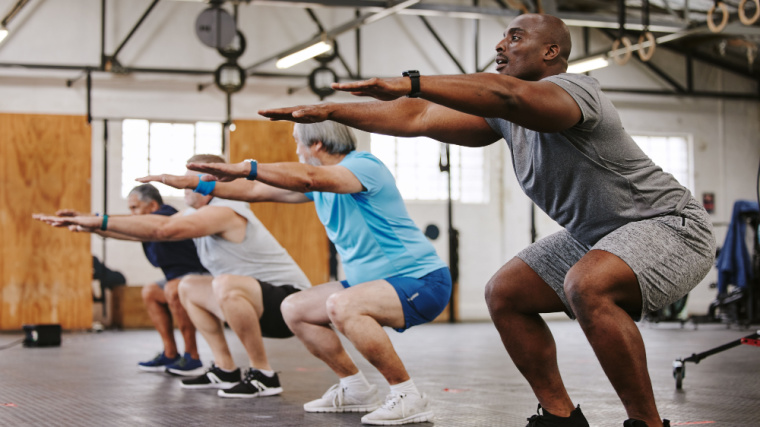Muscle Insider
New member
From calisthenics training to gathering the best dumbbells at your disposal for a sweat session, there are endless ways to pack in a quick, high-intensity workout. One of the most popular of these training methods is the Tabata protocol. This unique spin on interval training was originally popularized back in 1996 and traces its roots back even further. ...
The post What Is Tabata Training? How to Get Fitter in Four Minutes appeared first on BarBend.
From calisthenics training to gathering the best dumbbells at your disposal for a sweat session, there are endless ways to pack in a quick, high-intensity workout. One of the most popular of these training methods is the Tabata protocol. This unique spin on interval training was originally popularized back in 1996 and traces its roots back even further.
 Credit: BearFotos / Shutterstock
Credit: BearFotos / Shutterstock
But not all short bursts of activity are created equal. Tabata training has very specific parameters, both in terms of how long you’re working and how hard you’re doing it. The quickest thing to remember about Tabata training is a 2:1 work:rest ratio. Read on for the nitty-gritty of how to get the most out of these workouts.
What Is Tabata Training?
In its simplest form, Tabata training has you work at all-out intensity for 20 seconds, followed by 10 seconds of complete rest. (1)
Tabata training calls for all-out bursts of maximum-effort anaerobic exercise. These bursts are followed by complete rest, unlike many high-intensity interval training (HIIT) workouts. So, you may be able to give it even more effort when you come back in.
[Read More: The 6 Benefits of HIIT to Inspire You to Go Hard]
On the other hand, you will be resting only half as much time as you’re working. That makes this protocol extremely challenging, especially when you’re truly pushing to your limits.
The Tabata Training Protocol
The original version of the Tabata used a bicycle to create an extremely challenging anaerobic cardio workout. (1) The following is an outline of the classic Tabata training protocol.
First, warm up at 50 percent of your VO2 max* for about 10 minutes. Then perform:
[Read More: Use High-Intensity Training to Unlock New Gains]
Repeat this work-to-rest ratio and accumulate a four-minute workout to be exhausted by the seventh or eighth round. (1)
* For reference, your VO2 max is the maximum amount of oxygen you can process during intense, all-out exercise. The higher you can train this number to be, the more efficiently and effectively you’ll be able to work out.
Make sure you cool down afterward, as well.
Bodyweight Tabata Training Exercises
Many Tabata protocols today use bodyweight exercises like push-ups and bodyweight squats. Keep in mind that for relatively simple bodyweight options like these, you’ll get your blood pumping, but likely not to the tune of over 170 percent of your VO2 max. So, it might not be “Tabata” in the truest sense of the word.
 Credit: PeopleImages.com – Yuri A / Shutterstock
Credit: PeopleImages.com – Yuri A / Shutterstock
[Read More: The 5 Best HIIT Treadmill Workouts to Bring Some Heart to Your Training]
Still, these moves pack a challenging amount of volume into a short period. Research suggests that you can, indeed, improve your cardiorespiratory endurance using bodyweight-only movements in repeated bouts of Tabata training. (2)
Here are some bodyweight-only options for Tabata training:
If you really want to push your muscles to the limit, you can stick with the same exercise throughout the four-minute protocol. But if you want a full-body workout, you can instead opt for cycling through the exercises, doing the first 20 seconds with push-ups, then bodyweight squats, etc.
Dumbbell Tabata Training Exercises
In many cases, using dumbbells will help jack your heart rate higher simply by virtue of adding an external load. But that doesn’t mean you should take it easier with more weight in your hands. Even if you’re using free weights, make sure you’re choosing an option that’s light enough for you to really go all out with no pauses during your 20-second sessions.
Cardio Tabata Training Exercises
To stay as true as possible to the original intent of Tabata protocols, you might want to stick to high-intensity cycling. Here are some cardio-based options to integrate into your Tabata protocol. All you have to do is go for 20 seconds as hard as possible, come to a complete rest for 10 seconds, and repeat for four minutes.
Try “sprinting” on any of the following pieces of cardio equipment:
Because you’ll want to run all 20 seconds and then come to a full stop for 10 seconds, it might be more efficient to do a Tabata protocol on an outdoor track instead of a treadmill.
[Read More: 30-Minute Treadmill Workouts to Build Stamina and Strength]
However, if you have the experience, skill, and confidence you need to use the handrails and simply hop on and off the treadmill while the belt is moving, you can do that, too. Just be extra careful.
The History of Tabata Training
Tabata training is named after its creator, Japanese exercise scientist Dr. Izumi Tabata. (1) As information about the science and benefits of classically prescribed HIIT and SIT (sprint interval training) emerged, Dr. Tabata began experimenting with his unique spin on the subject. His goal? To help maximize the efficiency and effectiveness of training for Olympic athletes. (1)
One of the earliest types of Tabata workouts was performed on a bicycle, featuring short bursts of high effort meant to fatigue the subjects quickly due to very short rest periods. The overarching goal was that participants would be physically exhausted after the seventh or eighth round of exercise. (1) In the Tabata protocol, that only takes four minutes.
One of the main goals was to increase athletes’ maximal accumulation of oxygen deficit (MAOD) — in other words, how efficiently you can produce energy anaerobically. Will you be completely brought to your knees after a single bout of intense anaerobic activity? Or can you train yourself to increase your anaerobic work capacity so you can rise to sprint again?
 Credit: oneinchpunch / Shutterstock
Credit: oneinchpunch / Shutterstock
In pursuit of a protocol to boost this anaerobic capacity, Dr. Tabata combined the following training parameters:
[Read More: Low Impact, 15-Minute HIIT Kettlebell Circuit]
Dr. Tabata first published information about his Tabata protocol in 1996. Since then, it has evolved to include a diverse selection of exercise types and training implements as the public has continued to tinker with the workout.
Instead of using exclusively bicycles as the Tabata training tool, now it is common to see any number of “Tabata-style” workouts. Generally speaking, the Tabata label gets put onto any interval protocol that denotes a 2:1 work:rest ratio — especially if it’s 20 seconds of work to 10 seconds of rest.
Strictly, that’s not accurate without the attention to working at an extremely high VO2 max. But as long as you know the intent — to work very hard — you should be good to go for gains.
Tabata Vs. HIIT
With Tabata training, you’ll work hard, then rest, and then do it all again. In this way, it is similar to HIIT. Both methods are meant to have you work very hard for a short burst of time.
But the Tabata protocol is a lot more specific than that. For one, you can manipulate the work and rest times to various ratios with HIIT. You might do a 1:1 work:rest ratio, or you might rest for twice as long as you work. But in Tabata, the ratio is always 2:1, with 20 seconds of work and 10 seconds of rest.
[Read More: What is AMRAP: How to Do it, Benefits, and AMRAP Workouts]
With HIIT, you may still perform some slow movements during your rest periods. For example, you may walk or slowly jog during the recovery phase of your sprint workouts. But in Tabata, the idea is that you stop altogether during rest periods.
Complete rest in between high-intensity bursts aims to prevent active recovery, meaning that very specific anaerobic energy systems are the continuous target throughout Tabata workouts.
What the Science Says About Tabata Training
The research on Tabata training has shown some very favorable results, even accounting for the relative lack of standardized guidelines for what constitutes a true Tabata workout.
In one study, adult participants performing four rounds of the protocol using calisthenic exercises experienced enough gains to meet the guidelines for improving cardiorespiratory endurance as outlined by the American College of Sports Medicine (ACSM). (2)
This means that Tabata is an extremely viable alternative for low or moderate-intensity cardiovascular training. It’s worth noting that participants in this particular study performed bodyweight moves like high knee runs, jumping jacks, Russian twists, and burpees in their Tabata-esque protocol. They also performed five rounds — for a total of 20 minutes — instead of just doing a four-minute-and-done protocol.
For trained athletes sticking to a more traditional Tabata protocol (eight rounds of intense activity with 20 seconds of work and 10 seconds of rest), studies suggest that the method can indeed improve maximal oxygen uptake and resting heart rate. (3)
 Credit: Gorgev / Shutterstock
Credit: Gorgev / Shutterstock
[Read More: Everything You Need to Know About LISS Cardio and Why You Should Do It]
Many athletes may turn to Tabata training with the goal of weight loss. However, research suggests that Tabata protocols are generally more effective at increasing cardiovascular fitness and aerobic power than they are at aiding weight loss. (4)
If you’re an advanced athlete, you might be prone to dismissing Tabata protocols as more focused on beginners. (Ironically, beginners may be intimidated by such high-intensity work and such short rest periods.)
Research suggests that experienced and inexperienced athletes alike find Tabata protocols to be extremely challenging, while both types of athletes gain similar cardiovascular benefits from the protocols. (5)
High Intensity for High Gains
The idea that you can pack a cardiovascular punch into a four-minute package might seem too good to be true. But if you’re taking your Tabata protocol to the max, you do stand to see large returns on your sweat investment.
With a tremendous amount of customization and a bite-sized time commitment, you’d be surprised at how easy (yet challenging) it is to weave in your cardio training. Whether you run a Tabata-style workout or the true Tabata protocol, you’re in for a fast, effective, and cardio-boosting experience.
FAQs
Tabata may seem straightforward, but it’s so intense that you’ll want to make sure you’ve got it right in your head before putting it into action with your body.
What is the difference between HIIT and Tabata?[/b] HIIT and Tabata training are different primarily in the way you rest between bursts of activity. HIIT has you use active recovery (such as walking or lower-intensity exercise), whereas Tabata calls for you to completely stop and rest without movement.
Tabata also uses a very specific 20-second activity and 10-second rest ratio, whereas HIIT allows for several different ratios to target different goals.
How often should you do Tabata workouts for optimal results?[/b] Early research points in the direction of about two high-intensity training sessions per week as a benchmark. (1) Higher-intensity styles of cardio seemed to meet a similar amount of cardiovascular benefits as the recommended four sessions per week at more moderate intensities. (1)
Of course, these numbers may change as your body adapts to increasing demands. You can likely take your workouts harder as you gain work capacity, so long as your recovery remains dialed in.
How long should a typical Tabata session last?[/b] Tabata workouts are specifically separated into four-minute pockets of activity. A single Tabata protocol is eight rounds of 20 seconds on and 10 seconds off.
Depending on your experience level and goals, you can string Tabata protocols together, lasting anywhere from a single four-minute burst to several in a row lasting up to 20 minutes.
References
[*]Tabata I. (2019). Tabata training: one of the most energetically effective high-intensity intermittent training methods. The journal of physiological sciences : JPS, 69(4), 559–572.
[*]Emberts, T., Porcari, J., Dobers-Tein, S., Steffen, J., & Foster, C. (2013). Exercise intensity and energy expenditure of a tabata workout. Journal of sports science & medicine, 12(3), 612–613.
[*]Lu Y, Wiltshire HD, Baker JS, Wang Q, Ying S. The effect of Tabata-style functional high-intensity interval training on cardiometabolic health and physical activity in female university students. Front Physiol. 2023 Feb 27;14:1095315.
[*]Viana RB, de Lira CAB, Naves JPA, Coswig VS, Del Vecchio FB, Gentil P. Tabata protocol: a review of its application, variations and outcomes. Clin Physiol Funct Imaging. 2019 Jan;39(1):1-8.
[*]Reppa CM, Bogdanis GC, Stavrou NAM, Psychountaki M. The Effect of Aerobic Fitness on Psychological, Attentional and Physiological Responses during a Tabata High-Intensity Interval Training Session in Healthy Young Women. Int J Environ Res Public Health. 2023 Jan 5;20(2):1005.
Featured Image: BearFotos / Shutterstock
The post What Is Tabata Training? How to Get Fitter in Four Minutes appeared first on BarBend.
Click here to view the article.
The post What Is Tabata Training? How to Get Fitter in Four Minutes appeared first on BarBend.
From calisthenics training to gathering the best dumbbells at your disposal for a sweat session, there are endless ways to pack in a quick, high-intensity workout. One of the most popular of these training methods is the Tabata protocol. This unique spin on interval training was originally popularized back in 1996 and traces its roots back even further.

But not all short bursts of activity are created equal. Tabata training has very specific parameters, both in terms of how long you’re working and how hard you’re doing it. The quickest thing to remember about Tabata training is a 2:1 work:rest ratio. Read on for the nitty-gritty of how to get the most out of these workouts.
What Is Tabata Training?
In its simplest form, Tabata training has you work at all-out intensity for 20 seconds, followed by 10 seconds of complete rest. (1)
Tabata training calls for all-out bursts of maximum-effort anaerobic exercise. These bursts are followed by complete rest, unlike many high-intensity interval training (HIIT) workouts. So, you may be able to give it even more effort when you come back in.
[Read More: The 6 Benefits of HIIT to Inspire You to Go Hard]
On the other hand, you will be resting only half as much time as you’re working. That makes this protocol extremely challenging, especially when you’re truly pushing to your limits.
The Tabata Training Protocol
The original version of the Tabata used a bicycle to create an extremely challenging anaerobic cardio workout. (1) The following is an outline of the classic Tabata training protocol.
First, warm up at 50 percent of your VO2 max* for about 10 minutes. Then perform:
- 20 seconds of supra maximal (170% of VO2 max) cycling
- 10 seconds of rest (completely stationary)
[Read More: Use High-Intensity Training to Unlock New Gains]
Repeat this work-to-rest ratio and accumulate a four-minute workout to be exhausted by the seventh or eighth round. (1)
* For reference, your VO2 max is the maximum amount of oxygen you can process during intense, all-out exercise. The higher you can train this number to be, the more efficiently and effectively you’ll be able to work out.
Make sure you cool down afterward, as well.
Bodyweight Tabata Training Exercises
Many Tabata protocols today use bodyweight exercises like push-ups and bodyweight squats. Keep in mind that for relatively simple bodyweight options like these, you’ll get your blood pumping, but likely not to the tune of over 170 percent of your VO2 max. So, it might not be “Tabata” in the truest sense of the word.

[Read More: The 5 Best HIIT Treadmill Workouts to Bring Some Heart to Your Training]
Still, these moves pack a challenging amount of volume into a short period. Research suggests that you can, indeed, improve your cardiorespiratory endurance using bodyweight-only movements in repeated bouts of Tabata training. (2)
Here are some bodyweight-only options for Tabata training:
- Push-Up
- Bodyweight Squat
- Jump Squat
- Jumping Lunge
- Skater
- High Knee
- Burpee
- Split Squat
- Box Jump
- Russian Twist
- Jumping Jack
- Mountain Climber
If you really want to push your muscles to the limit, you can stick with the same exercise throughout the four-minute protocol. But if you want a full-body workout, you can instead opt for cycling through the exercises, doing the first 20 seconds with push-ups, then bodyweight squats, etc.
Dumbbell Tabata Training Exercises
In many cases, using dumbbells will help jack your heart rate higher simply by virtue of adding an external load. But that doesn’t mean you should take it easier with more weight in your hands. Even if you’re using free weights, make sure you’re choosing an option that’s light enough for you to really go all out with no pauses during your 20-second sessions.
- Dumbbell Thruster
- Dumbbell Clean & Press
- Alternating Dumbbell Snatch
Cardio Tabata Training Exercises
To stay as true as possible to the original intent of Tabata protocols, you might want to stick to high-intensity cycling. Here are some cardio-based options to integrate into your Tabata protocol. All you have to do is go for 20 seconds as hard as possible, come to a complete rest for 10 seconds, and repeat for four minutes.
Try “sprinting” on any of the following pieces of cardio equipment:
Because you’ll want to run all 20 seconds and then come to a full stop for 10 seconds, it might be more efficient to do a Tabata protocol on an outdoor track instead of a treadmill.
[Read More: 30-Minute Treadmill Workouts to Build Stamina and Strength]
However, if you have the experience, skill, and confidence you need to use the handrails and simply hop on and off the treadmill while the belt is moving, you can do that, too. Just be extra careful.
The History of Tabata Training
Tabata training is named after its creator, Japanese exercise scientist Dr. Izumi Tabata. (1) As information about the science and benefits of classically prescribed HIIT and SIT (sprint interval training) emerged, Dr. Tabata began experimenting with his unique spin on the subject. His goal? To help maximize the efficiency and effectiveness of training for Olympic athletes. (1)
One of the earliest types of Tabata workouts was performed on a bicycle, featuring short bursts of high effort meant to fatigue the subjects quickly due to very short rest periods. The overarching goal was that participants would be physically exhausted after the seventh or eighth round of exercise. (1) In the Tabata protocol, that only takes four minutes.
One of the main goals was to increase athletes’ maximal accumulation of oxygen deficit (MAOD) — in other words, how efficiently you can produce energy anaerobically. Will you be completely brought to your knees after a single bout of intense anaerobic activity? Or can you train yourself to increase your anaerobic work capacity so you can rise to sprint again?

In pursuit of a protocol to boost this anaerobic capacity, Dr. Tabata combined the following training parameters:
[Read More: Low Impact, 15-Minute HIIT Kettlebell Circuit]
- Target large muscle groups (to maximize muscle involvement)
- Bursts of extremely high-intensity activity (20-second work intervals)
- Very short rest periods (10-second rest intervals)
Dr. Tabata first published information about his Tabata protocol in 1996. Since then, it has evolved to include a diverse selection of exercise types and training implements as the public has continued to tinker with the workout.
Instead of using exclusively bicycles as the Tabata training tool, now it is common to see any number of “Tabata-style” workouts. Generally speaking, the Tabata label gets put onto any interval protocol that denotes a 2:1 work:rest ratio — especially if it’s 20 seconds of work to 10 seconds of rest.
Strictly, that’s not accurate without the attention to working at an extremely high VO2 max. But as long as you know the intent — to work very hard — you should be good to go for gains.
Tabata Vs. HIIT
With Tabata training, you’ll work hard, then rest, and then do it all again. In this way, it is similar to HIIT. Both methods are meant to have you work very hard for a short burst of time.
But the Tabata protocol is a lot more specific than that. For one, you can manipulate the work and rest times to various ratios with HIIT. You might do a 1:1 work:rest ratio, or you might rest for twice as long as you work. But in Tabata, the ratio is always 2:1, with 20 seconds of work and 10 seconds of rest.
[Read More: What is AMRAP: How to Do it, Benefits, and AMRAP Workouts]
With HIIT, you may still perform some slow movements during your rest periods. For example, you may walk or slowly jog during the recovery phase of your sprint workouts. But in Tabata, the idea is that you stop altogether during rest periods.
Complete rest in between high-intensity bursts aims to prevent active recovery, meaning that very specific anaerobic energy systems are the continuous target throughout Tabata workouts.
What the Science Says About Tabata Training
The research on Tabata training has shown some very favorable results, even accounting for the relative lack of standardized guidelines for what constitutes a true Tabata workout.
In one study, adult participants performing four rounds of the protocol using calisthenic exercises experienced enough gains to meet the guidelines for improving cardiorespiratory endurance as outlined by the American College of Sports Medicine (ACSM). (2)
This means that Tabata is an extremely viable alternative for low or moderate-intensity cardiovascular training. It’s worth noting that participants in this particular study performed bodyweight moves like high knee runs, jumping jacks, Russian twists, and burpees in their Tabata-esque protocol. They also performed five rounds — for a total of 20 minutes — instead of just doing a four-minute-and-done protocol.
For trained athletes sticking to a more traditional Tabata protocol (eight rounds of intense activity with 20 seconds of work and 10 seconds of rest), studies suggest that the method can indeed improve maximal oxygen uptake and resting heart rate. (3)

[Read More: Everything You Need to Know About LISS Cardio and Why You Should Do It]
Many athletes may turn to Tabata training with the goal of weight loss. However, research suggests that Tabata protocols are generally more effective at increasing cardiovascular fitness and aerobic power than they are at aiding weight loss. (4)
If you’re an advanced athlete, you might be prone to dismissing Tabata protocols as more focused on beginners. (Ironically, beginners may be intimidated by such high-intensity work and such short rest periods.)
Research suggests that experienced and inexperienced athletes alike find Tabata protocols to be extremely challenging, while both types of athletes gain similar cardiovascular benefits from the protocols. (5)
High Intensity for High Gains
The idea that you can pack a cardiovascular punch into a four-minute package might seem too good to be true. But if you’re taking your Tabata protocol to the max, you do stand to see large returns on your sweat investment.
With a tremendous amount of customization and a bite-sized time commitment, you’d be surprised at how easy (yet challenging) it is to weave in your cardio training. Whether you run a Tabata-style workout or the true Tabata protocol, you’re in for a fast, effective, and cardio-boosting experience.
FAQs
Tabata may seem straightforward, but it’s so intense that you’ll want to make sure you’ve got it right in your head before putting it into action with your body.
What is the difference between HIIT and Tabata?[/b] HIIT and Tabata training are different primarily in the way you rest between bursts of activity. HIIT has you use active recovery (such as walking or lower-intensity exercise), whereas Tabata calls for you to completely stop and rest without movement.
Tabata also uses a very specific 20-second activity and 10-second rest ratio, whereas HIIT allows for several different ratios to target different goals.
How often should you do Tabata workouts for optimal results?[/b] Early research points in the direction of about two high-intensity training sessions per week as a benchmark. (1) Higher-intensity styles of cardio seemed to meet a similar amount of cardiovascular benefits as the recommended four sessions per week at more moderate intensities. (1)
Of course, these numbers may change as your body adapts to increasing demands. You can likely take your workouts harder as you gain work capacity, so long as your recovery remains dialed in.
How long should a typical Tabata session last?[/b] Tabata workouts are specifically separated into four-minute pockets of activity. A single Tabata protocol is eight rounds of 20 seconds on and 10 seconds off.
Depending on your experience level and goals, you can string Tabata protocols together, lasting anywhere from a single four-minute burst to several in a row lasting up to 20 minutes.
References
[*]Tabata I. (2019). Tabata training: one of the most energetically effective high-intensity intermittent training methods. The journal of physiological sciences : JPS, 69(4), 559–572.
[*]Emberts, T., Porcari, J., Dobers-Tein, S., Steffen, J., & Foster, C. (2013). Exercise intensity and energy expenditure of a tabata workout. Journal of sports science & medicine, 12(3), 612–613.
[*]Lu Y, Wiltshire HD, Baker JS, Wang Q, Ying S. The effect of Tabata-style functional high-intensity interval training on cardiometabolic health and physical activity in female university students. Front Physiol. 2023 Feb 27;14:1095315.
[*]Viana RB, de Lira CAB, Naves JPA, Coswig VS, Del Vecchio FB, Gentil P. Tabata protocol: a review of its application, variations and outcomes. Clin Physiol Funct Imaging. 2019 Jan;39(1):1-8.
[*]Reppa CM, Bogdanis GC, Stavrou NAM, Psychountaki M. The Effect of Aerobic Fitness on Psychological, Attentional and Physiological Responses during a Tabata High-Intensity Interval Training Session in Healthy Young Women. Int J Environ Res Public Health. 2023 Jan 5;20(2):1005.
Featured Image: BearFotos / Shutterstock
The post What Is Tabata Training? How to Get Fitter in Four Minutes appeared first on BarBend.
Click here to view the article.









